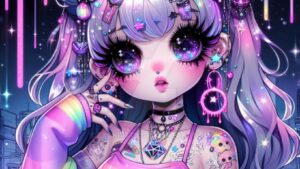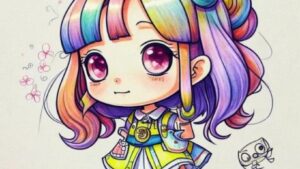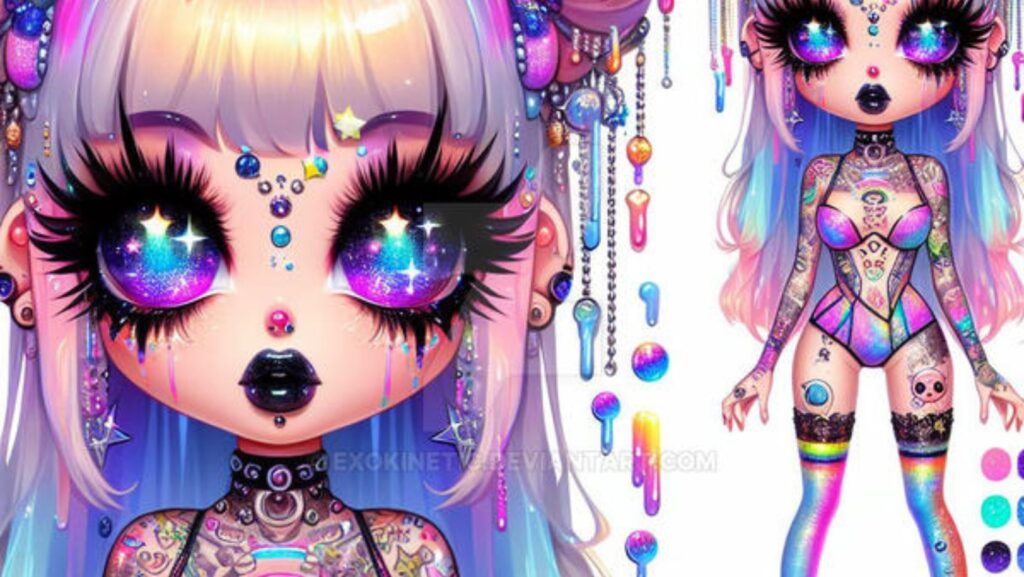In the vibrant world of art and design, the term “kawaii” has transcended its Japanese origins to become a global phenomenon. Characterized by its adorable aesthetic, kawaii art, particularly in the form of drawings or “dibujos,” captivates audiences with its emphasis on cuteness and simplicity. This style, which emerged from the streets of Japan, now influences everything from fashion to media, artificial intelligence designs and even everyday products in the gaming industry.
Kawaii:zzkrcgmtkfc= Dibujos
Kawaii art captivates with its emphasis on cuteness and simplicity. This section explores the origins and popularity of Kawaii drawings, a style deeply woven into the fabric of contemporary culture and visual contents.
Origins of the Term
 Kawaii, meaning “cute” or “lovable” in Japanese, originated from a 1970s cultural shift in Japan. The term traces back to a youth movement that embraced a new way of handwriting that was round and child-like, known as “marui-ji.” This cute style quickly spilled over into other forms of media, including comic books and advertisements. By the 1980s, kawaii had become an inherent part of Japanese popular culture, defining not only artistic aesthetics but also the everyday lifestyle of countless individuals. It represents more than just a superficial quality; kawaii reflects a deep-seated ethos of gentleness, humility, and affection.
Kawaii, meaning “cute” or “lovable” in Japanese, originated from a 1970s cultural shift in Japan. The term traces back to a youth movement that embraced a new way of handwriting that was round and child-like, known as “marui-ji.” This cute style quickly spilled over into other forms of media, including comic books and advertisements. By the 1980s, kawaii had become an inherent part of Japanese popular culture, defining not only artistic aesthetics but also the everyday lifestyle of countless individuals. It represents more than just a superficial quality; kawaii reflects a deep-seated ethos of gentleness, humility, and affection.
Popularity and Trends
The globalization of kawaii can be attributed to its enormous appeal in digital and media spaces beyond Japan. Iconic characters such as Hello Kitty and Pikachu exemplify kawaii and have become globally recognized symbols of Japanese culture. In recent years, the proliferation of social media platforms like Instagram and Pinterest has facilitated a surge in kawaii’s popularity. Users often share images of art, fashion, and merchandise inspired by this style, further disseminating its aesthetic globally. Today, kawaii is more than a niche interest; it’s a significant element of global pop culture, influencing various domains, including fashion, art, marketing, and technology, and it continues yielding new trends regularly.
Visual Elements of Kawaii:zzkrcgmtkfc= Dibujos
Character Design
 Character design in kawaii:zzkrcgmtkfc= dibujos prioritizes simplicity and an immediate emotional connection. Common features include large eyes, small mouths, and rounded shapes, enhancing the characters’ overall cuteness. These elements evoke a sense of vulnerability and endearment, making characters like Hello Kitty universally beloved. Often, designers will emphasize physical attributes that suggest innocence and childlike wonder, such as exaggerated head sizes or small bodies. This method not only makes kawaii characters visually appealing but also universally relatable.
Character design in kawaii:zzkrcgmtkfc= dibujos prioritizes simplicity and an immediate emotional connection. Common features include large eyes, small mouths, and rounded shapes, enhancing the characters’ overall cuteness. These elements evoke a sense of vulnerability and endearment, making characters like Hello Kitty universally beloved. Often, designers will emphasize physical attributes that suggest innocence and childlike wonder, such as exaggerated head sizes or small bodies. This method not only makes kawaii characters visually appealing but also universally relatable.
Color Schemes
The choice of color in kawaii:zzkrcgmtkfc= dibujos is essential in conveying the art’s inherent charm. Pastel hues dominate the palette, encompassing soft pinks, baby blues, mint greens, and lavender. These colors contribute to a gentle and soothing visual impact, closely tied to the themes of peace and affection inherent in kawaii culture. Occasionally, vibrant colors like bright yellow or neon pink are used to highlight small details or add a playful contrast, enhancing the visual allure and emotional engagement of the drawings. This strategic use of color not only differentiates kawaii art from more traditional styles but also makes it particularly attractive in digital and print formats where color vibrancy can be highly controlled.
Cultural Impact of Kawaii:zzkrcgmtkfc= Dibujos
Influence on International Art
 Kawaii’s aesthetic has transcended Japanese culture to inspire a global community of artists and designers. In cities from Paris to New York, galleries have hosted exhibitions dedicated to kawaii’s impact, drawing substantial crowds eager to revel in its joyful simplicity. Artists incorporate the distinctive traits of kawaii, such as exaggerated cuteness and vibrant color palettes, into their works, creating new sub-genres and sparking artistic innovation. These contributions help bridge cultural gaps, allowing for more universal appreciation and understanding of kawaii’s unique stylistic elements.
Kawaii’s aesthetic has transcended Japanese culture to inspire a global community of artists and designers. In cities from Paris to New York, galleries have hosted exhibitions dedicated to kawaii’s impact, drawing substantial crowds eager to revel in its joyful simplicity. Artists incorporate the distinctive traits of kawaii, such as exaggerated cuteness and vibrant color palettes, into their works, creating new sub-genres and sparking artistic innovation. These contributions help bridge cultural gaps, allowing for more universal appreciation and understanding of kawaii’s unique stylistic elements.
Merchandising and Media Expansion
Kawaii has not only influenced visual arts but has also become a powerful force in merchandising and media. Major brands across industries adopt kawaii elements to design appealing consumer products, from toys and clothing to household items, tapping into the style’s widespread popularity. Additionally, collaborations between international media houses and Japanese studios have resulted in kawaii-themed animations and video games reaching global audiences.



